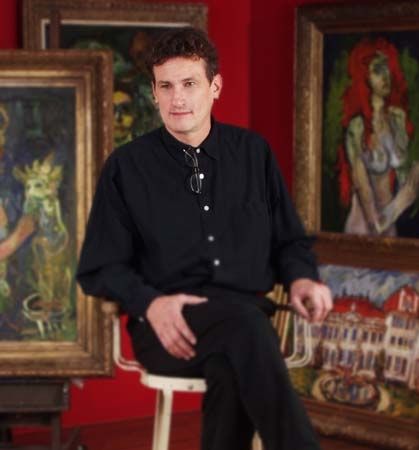Style trumps pretty much everything except
aesthetics according to artist Tim Johnson. It’s an adage clearly manifested in
the 33 pieces that comprise his current show at Fort Wayne’s Kachmann Gallery,
1301 Lafayette Street. These mostly large, always imposing, oil images
make up a sort of travelogue of sights, scenes and architecture painted on
sites that vary from the Lake Michigan shoreline to the Louisiana countryside
to the northern Italy lake country all the way to the Mediterranean coastline
of southern France, where the artist now makes his home.
Sumptuously stroked, Johnson’s expressionist effigies
attest to an eye trained in its focus and tempered by captured light. His skies
seem drawn from the same color vat as the firmament, and he latches onto
diffused rays that reflect water. To gain his perspective he might sit plein
air along a street or along a rural, countryside lane. In Europe his easel and
chair might be accompanied by a bottle of his favorite wine. Other vistas, accessible
only from the water, are realized from various watercraft: a borrowed boat in
Michigan, a rented Italian skiff or from the deck of his own motor launch in
the waters off Cannes.
Not exactly a vagabond without roots, the
51-year-old Johnson was born and raised in Fort Wayne and for the last decade
has made his home, along with his wife Catherine and their son, eight-year-old
John-Baptiste, in the south of France near Cannes. Nurtured in the fine arts by
his father, “Whitey,” himself an artist and art teacher, the younger
Johnson studied at the former Saint Francis College and the Fort Wayne Art
Institute before earning degrees at Indiana University in Bloomington and
Bowling Green State University.
As romantic as his life and work may appear to us
stay-at-homes, the ruggedly handsome Johnson remains a hard working,
down-to-earth Yankee, sans any faux pretenses. Aside from a velour Givenchy
jacket and Gucci loafers, appropriate wear for a gallery opening, he’s most
comfortable in jeans and a ragged-at-the-edge T-shirt. He relates, however,
that with the current growing backlash against American foreign policy it can
be difficult to be an American amongst his European associates.
“I’ve, of necessity, grown thick skinned of
late to deal with the anti-Americanism. You simply have to to be able to deal
in the real world. Things have become ever so complex,” he mused recently
over a huge bowl of noodle soup at the Saigon, his favorite local restaurant.
“Even the simple things. For example, it
gets harder and harder to go back to the Uffizi gallery in Florence where
they’ve put plexi-glass over some of the most precious artwork. I was forced to
get used to it with the Mona Lisa, but now it’s becoming commonplace, and you
can imagine how it is for a painter who wants to examine such masterworks up
close – having to dodge the reflections to peer through the protective plastic
packaging.”
He can also get a bit edgy when talk turns to
wine. “Some things that pass for being good wine in the States would be vin
ordinaire or vin militaire in France. I’m in no way a true connoisseur, but
there is such a thing as good taste.”
Yes, Johnson has picked up a fair amount of
French. He is a licensed antique dealer and negotiates for his commercial
framing business in several continental languages. He’s particularly proud of
the marine navigation license needed to operate his boat, which he received
after passing a 200-question test, given in French.
And when it comes to good taste in any language
you have to consider Johnson’s paintings almost in the same breath as their
unique and often magnificent frames. Complementary as they are, they never
upstage his paintings, though it’s hard not to notice a vintage 18th century
hand-carved, gilded frame.
“I was alert and lucky enough to notice a
potential market for these unique antique frames a few years back,”
Johnson relates. “The workmanship and artistry is [sic] pretty
extraordinary when you consider they were done with basic tooling. Some are
signed by the craftsman, and it can be a special thing to behold once you
realize it is a 300-year-old object you’re admiring.
“Like any other business or line of work, it
can be tough and time-consuming. Not every find can be authentic, but I’ve
developed a string of dealers who are attuned to what I’m after, and I’m always
improving my negotiating skills.”
Returning to his paintings, it’s amazing how
consistent his style has become since his last local show nearly three years
ago. He really does stamp our ticket on this scenic tour de force. Missing,
however, is an audio accompaniment to provide the background and setting for
some of these pieces.
For example in one of the highlight works (there
are actually a pair of them), Prison de Masque de Fer. The paintings are of the prison
which housed the Man in the Iron Mask, out of which came Alexandre Dumas’ novel
of the same name. It’s a work that begs for explanation.
Every picture tells a story, it is said, and
Johnson’s current collection – whether in frame or image – abounds in them. The
artist makes a wonderful guide, and his stories, at least the ones we can
print, make for a rewarding excursion.
 Submit Your Event
Submit Your Event
